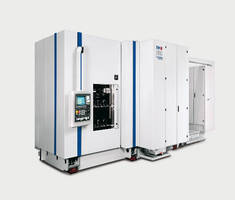Global Data Acquisition Is Worthwhile

Nowadays, machine tools can be subjected to a comprehensive data acquisition via the Internet. This no longer concerns just the status-oriented maintenance. The acquired data can be used for the maintenance, production and management areas. This means, for example, accurate statements can be made about the overall costs of a machine over its lifecycle (TCO). This article describes the services that the Schwäbische Maschinenwerkzeuge GmbH offers its customers, based on the ePS services provided from Siemens.
The appropriateness of online services in the machine tool environment has already been discussed for several years and this will continue into the future. Whereas several companies already use the modern technologies to bring transparency not only to the associated states of their machines but also to the production processes, other companies are still asking, "For what purpose should we investigate such a protocol of machine status monitoring?"
Does it make sense to spend money for such services? Is it not dangerous for a company to operate machines connected to the Internet? Can the machine status data be used to make decisions for production processes, beyond the obvious maintenance requirements?
Meanwhile, all these questions have been already been answered in the positive by Schwäbische Maschinenwerkzeuge GmbH (SW), a major German machine tool manufacturer. For many years, the company has already been providing a comprehensive monitoring of their machine data. "What is new is that this global data acquisition allows us not only to determine the ideal intervals for a use-dependent maintenance, but also to provide customer-specific matched solutions with very useful background information for the production. This gives the management a transparency that it does not have otherwise," says Peter Siegel, responsible for the development of online services at SW.
Productivity and high accuracy
Schwäbische Maschinenwerkzeuge GmbH in Schramberg-Waldmössingen, Black Forest, Germany, was founded in 1994 from the Heckler & Koch machine construction company at Oberndorf and, since 2004, has been the competence center within the EMAG group for the machining of prismatic workpieces. The company, with its 330 employees, produces approximately 160 machine tools annually. High-performance 1- to 4-spindle machining centers and special machines are produced here.
Approximately 70 to 80 percent of SW's customers come from the automotive industry, with other application areas including medical technology and the hydraulic industry. SW sells its machine tools worldwide, with its main focus in Europe.
A special feature of the SW machines is certainly the multi-spindle capability coupled with very high precision, in particular the multi-spindle 5-axis machining centers. Those customers who do not want to produce anything other than "parts, parts, parts" can expect high productivity combined with high accuracy. To provide a small example: the machines normally have 12 to 19 NC axes and a working area approximately 600 x 600 x 600 mm for a single spindle machine, also 600 x 600 x 1200 mm for multi-spindle.
Another strength of SW is that it can also produce jigs and has acquired extensive know-how that allows the best-possible solution to be realized for its customers. After all, "90 to 95% of our customers demand complete solutions, including automation, rather than just standard machines," according to Peter Siegel.
Comprehensive view of the machines
Approximately 65% of the SW machines sold today are connected to the Internet. "However, by no means do all customers also use the resulting information fully. Many still envision the reactive maintenance service as the only possibility, namely, to do something only when a fault has already occurred, similar to Teleservice (another Siemens offering) previously," says Siegel.
Nowadays, however, it is possible to use the data to do something in advance and this not only with regards to the operational status of the machines.
The current state-of-the-art allows the machine (operational) data to be recorded continuously and consequently permit various conclusions to be drawn. This obviously requires that all relevant data be acquired. Consequently, several years ago, SW equipped its spindles with sensors, so their status can be checked without requiring them to be removed from the machining head.
Meanwhile, the global data recording allows useful conclusions to be obtained for all these areas:
maintenance
production
management.
"Our services provide the maintenance department with a powerful tool that makes its work simpler and faster," Siegel states. "The maintenance staff no longer needs to wait for our alerts and updates, they can also work with the data themselves."
In the production, the same data source can be used to perform other analyses, for example, how often has the JOG operation been selected, how long the setup takes, how long is the machine stopped without any malfunction being present, how long is the response time for a malfunction and much more.
"All this data makes it possible to determine the causes of qualitative problems, why processes are instable or why the number of produced parts falls suddenly. Ultimately, a process optimization and/or a productivity increase can be achieved," states Siegel.
Johannes Zuckschwerdt, technology development project engineer, uses an example to explain what a complete data monitoring can achieve. During an performance evaluation, one machine had, for example, a utilization time of 24 hours and consequently apparently no optimization potential. The data monitoring, however, showed that the machine alone was stopped for 100 minutes per day because it was waiting for loading acknowledgements. Assuming a cycle time of 1.2 minutes, 83 more parts could have been processed during this time. For a value of Euros 8 (~$12) per part, this would mean an added value of Euros 239,000 (~$358,000) over a year.
This is obviously a purely theoretical value. However, even if this value is divided by five or ten, a very impressive amount remains - per machine! These services pay for themselves very quickly, as SW's customer learned.
A third area that can benefit from the comprehensive data obtained via ePS is the operating or company management that obviously has an interest in optimum production and often needs to document the process reliability. The latter is particularly true in the automotive industry, where suppliers require a process validation protocol of some type.
Of particular importance for management is the overall cost of a machine over its lifecycle, the TCO or Total Cost of Ownership.
Realistic TCO values require the recorded operational data from the actual use. This data can be derived from the previously used condition monitoring or the acquisition of usage data. Although this allows the lifecycle costs to be calculated over several years, hidden potentials, such as process monitoring and optimization, remain undiscovered.
The complete data acquisition also discovers things such as creeping process deviations, machine state fluctuations or resource consumption. This allows them to be included in the overall cost consideration. At the same time, it is possible to counter their causes or correct them in a planned manner.
The global data storage on the ePS servers also gives machine constructors and end users the possibility to prepare comparisons for machines and processes (e.g. location-related issues for end users) and to create reports - through to the documentation of process reliability.
The SW data gives both the machine operator and its customer security. "All we need is an Internet access," explains Peter Siegel, "and our customer receives the complete services as described in our literature."
Although this may appear simple, in practice, several hurdles are frequently encountered.
Furthermore, there is general mistrust of Internet connections in production. However, this also requires that the IT department is involved in processes of this type. In the past, IT departments were not much concerned with NC controllers and other onboard controls. Today, controllers are part of the global network. It is now necessary to involve the IT department and to also open the required communications paths within the company. "The sooner, the better, as the saying goes," muses Siegel.
Hurdles of this type can be mastered only by communication and the establishing of mutual trust. Existing references help the builder here.
SW builds on ePS services
"It is not economical for us as machine tool manufacturers to provide the data processing platform for all these services. Consequently, for many years, we have been making use of ePS services that support us optimally," says Peter Siegel.
ePS Network Services, a Siemens subsidiary, characterizes itself as an Internet-based infrastructure with high-performance servers, storage media and connections to e-mail and SMS text messaging systems, as well as a source for software for the acquisition, preparation and archiving of machine-specific data.
For customers, this means "a costing reliability for the construction of Teleservice services, the use of a proven structure and a high data security provided by the ePS Network," as Jochen Heinz, consulting team leader for Value Added Services at Siemens, explains.
The services are compatible with the current IT security standards. The communication between the machines or service PCs and the ePS servers is limited to the ePS server and uses only certified software components. Access from external servers is not possible; in such a case, the client server simply does not execute the scripts. The communication is generally only established from the machine or the service PC to the ePS servers.
As Peter Siegel emphasizes, this, and also an additional encryption, has meant, "To date, no data leakage has ever occurred."
Future aspects
Peter Siegel also sees inter-company aspects for the future: "When I consider machine components that originate from third parties, for example spindles, then it is now possible to also involve their manufacturers. We can, for example, provide notification of a soon-pending maintenance or also for a required replacement."
This can certainly have positive effects on the spare parts planning. If a spindle manufacturer knows that it will require 20 or 50 spindles for customer "X" in six months, it can schedule such demands into its production forecast.
"One can further consider these concepts: when a measurement determines 'part worn', an appropriate order action can then be initiated automatically. We want to pursue this direction," says Siegel.
However, it is important to note, he adds, "We are neither spies nor robber barons, but rather we want to support our customers in the best possible manner, so they can operate our machines without any problems. Our dedicated involvement with our customers and our partnering with Siemens in this vital area are proving the value of this ePS service, every day," Siegel concludes.




